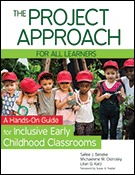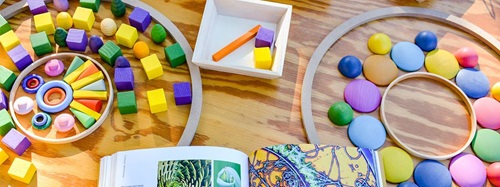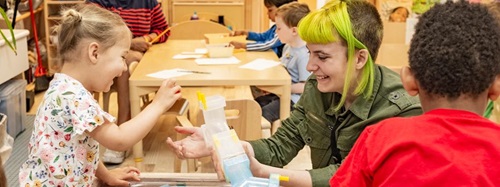The Project Approach for All Children:
Hands-on Learning for Inclusive Early Childhood Classrooms
| October 2019Engaging all children in interesting, motivating, and educational ways is sometimes very challenging for early childhood educators. This can be especially daunting when one considers the diverse abilities that might be present in a preschool classroom. Students range in age from three to five; their home language might not be English; their strengths vary from children who are fluent readers, can speak multiple languages, and have advanced numeracy skills, to some who are struggling learners with limited social skills, speech delays, or significant fine and gross motor disabilities.
In our research we found that implementing the Project Approach to early childhood curricula can help teachers engage each and every child in their classroom. In project work teachers build on children’s individual strengths and interests. Students develop a sense of community while working together to find answers to their questions and determining ways to represent their findings.
Typical lesson approaches, such as thematic units or a series of lessons from a commercially available curriculum, often include plans geared toward children at a particular level of development. Teachers must then adapt the plans for the diverse group of learners in their classrooms. In contrast, plans for project work emerge from and are negotiated between teachers and their students.
In project work, teachers identify a topic of high interest to most members of the class. Teachers then facilitate an in-depth study of the topic through firsthand investigation, reflection, and representation of their findings. Using children’s previous experience as a starting point, teachers introduce new experiences, materials, and resources that will help children satisfy their curiosity by investigating the topic with their whole bodies, senses, and minds. For example, children might study the various types of bread available in their community, how bread is made, how it smells, how it tastes, and community helpers who are involved in bread-making, packaging, and selling.
As children engage in project work, they learn about how the world around them works and develop confidence in their ability to figure things out. They learn how to work collaboratively with their peers as they seek for answers to their questions. In project work all children have opportunities to use their strengths to make contributions to the group and to appreciate the strengths and abilities of others. They gradually develop confidence in their own abilities and build perseverance as they experience the satisfaction that can come from overcoming obstacles and solving problems.

While children may learn literacy and numeracy skills through direct instruction, they appreciate the value of literacy and numeracy skills as they apply them in purposeful ways to aid in their investigation (i.e., how many cups of flour and teaspoons of salt go into making three loaves of bread). However, rather than focusing predominantly on academic achievement, the Project Approach strengthens children’s intellectual dispositions, such as analyzing, predicting, hypothesizing, explaining, and the skills involved in each of these dispositions.
Three phases provide a framework for the inquiry-based learning, which is at the heart of project work:
- In Phase I, teachers introduce the topic and provide children with opportunities to share what they already know about it through activities such as storytelling, dramatic play, and drawing. Teachers then identify aspects of the topic that the children are curious to learn more about.
- In Phase II, teachers provide children with activities that allow them to satisfy their curiosity, such as interviews with guest experts, field trips, experiments, research using informational texts, and examinations of artifacts. For instance, children might interview a local baker, look through recipe books, and taste several types of sweet and savory bread.
- When children have satisfied their curiosity, teachers introduce Phase III, which provides opportunities for children to reflect on and share what they have learned and experienced, and to celebrate their accomplishments.

The Project Approach serves as a universal design for learning, a principle that encourages teachers to plan goals, methods, materials, and assessments that provide all learners with equal access to the curriculum right from the start. The concept of universal design first emerged in the field of architecture. Architects worked to anticipate the needs of and plan physical spaces for the benefit of all people, including individuals with physical and intellectual disabilities. Consider how curb cuts enable wheelchair users to independently navigate from one point to another. Likewise, caregivers pushing strollers or pulling wagons, and individuals using walkers also benefit from environmental adaptations such as curb cuts, ramps into public buildings, wider aisles, and electronic doors to buildings that open as they sense that someone is nearing the entrance. Along these same lines, a universal design for learning approach offers a better learning environment for all children by providing multiple means of engagement, representation, and action and expression.
Multiple Means of Engagement refers to the range of ways that children can be motivated to participate, given their unique learning styles and challenges, interests, and preferences. In the course of project work artifacts related to the topic can be added to the environment to encourage children’s participation. The teacher could research and include topic-related vocabulary in the home language of a dual-language learner, or engage a child who is a sensorimotor learner by bringing in relevant materials that the child can feel, smell, and taste. Additionally, the teacher might post images of one aspect of the project that interests a particular child.
Multiple Means of Representation refers to the variety of ways in which a teacher can gather and share information with children that is responsive to their individual learning styles and experiences. For example, she might bring in visual supports (e.g., photos, drawings, felt board characters) to support the involvement of a child during large group.
Multiple Means of Action and Expression refers to the variety of child responses that demonstrate knowledge or skill, across ability levels. It is the way that individual children organize and express their thoughts. Teachers can provide children with developmentally appropriate opportunities to express themselves in a variety of formats (e.g., vocalize, use a picture exchange system/sign language/an augmentative communication system, through dramatic play, drawing).

The length of time it takes to move through all three phases of a project can vary depending on the richness of the topic, the time available to develop and sustain it, and the teacher’s desire and skills in sustaining the project. However, what is important is that all children can benefit from engagement in project work, albeit a two week project or one that last for months.
In project work children use their strengths and abilities to accomplish their plans, and the teacher supports and scaffolds all children so that they can participate fully. There are many possibilities for children to participate and to use their strengths in project work, teachers just need to think creatively and be open to the possibilities. For example, a child who has a significant language delay may not be able to verbally explain how she thinks the class should construct a bakery in the dramatic play area, but she may be able to draw her ideas as a way to share her contributions to the plans for construction. A child with an intellectual disability might volunteer to mix the blue and orange paints to make the brown paint that will be used to paint the bakery shelves, and a peer who is just learning English might discover opportunities to learn and practice new color names as she works alongside him. A child who avoids peer interactions might volunteer to help label the bakery items, and as he copies words alongside a peer a nearby teacher encourages him to engage in a conversation with the other child as they decide who will print what words.
Young children are naturally curious and have an inner drive that motivates them to satisfy their curiosity through hands-on interaction with subjects that are of interest to them. The Project Approach is a way of teaching that engages children in sustained inquiry-based learning.
For more information read the book:
The Project Approach for All Learners: A Hands-On Guide for Inclusive Early Childhood Classrooms










